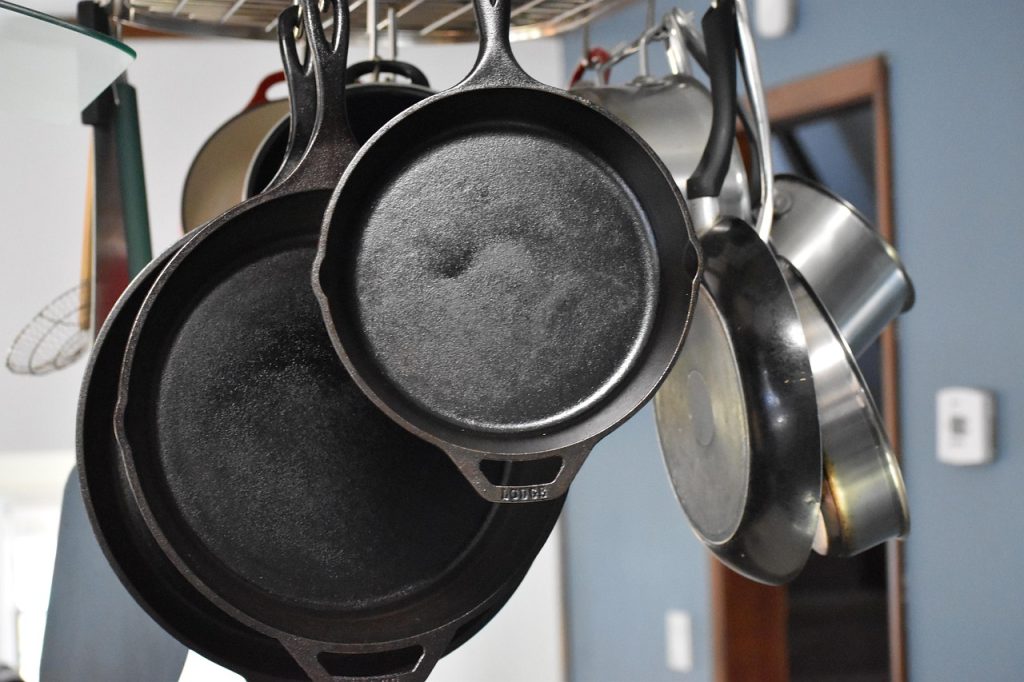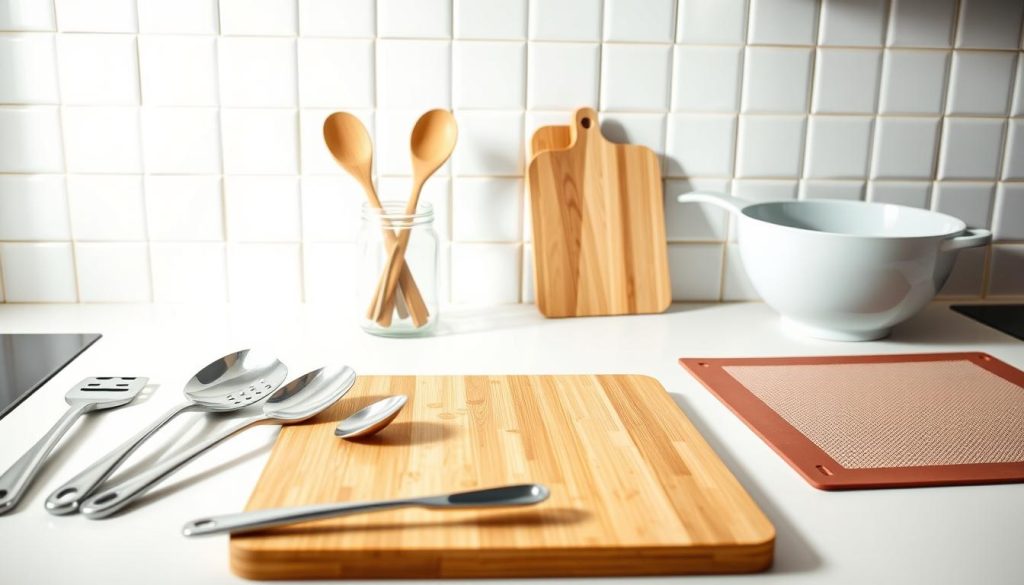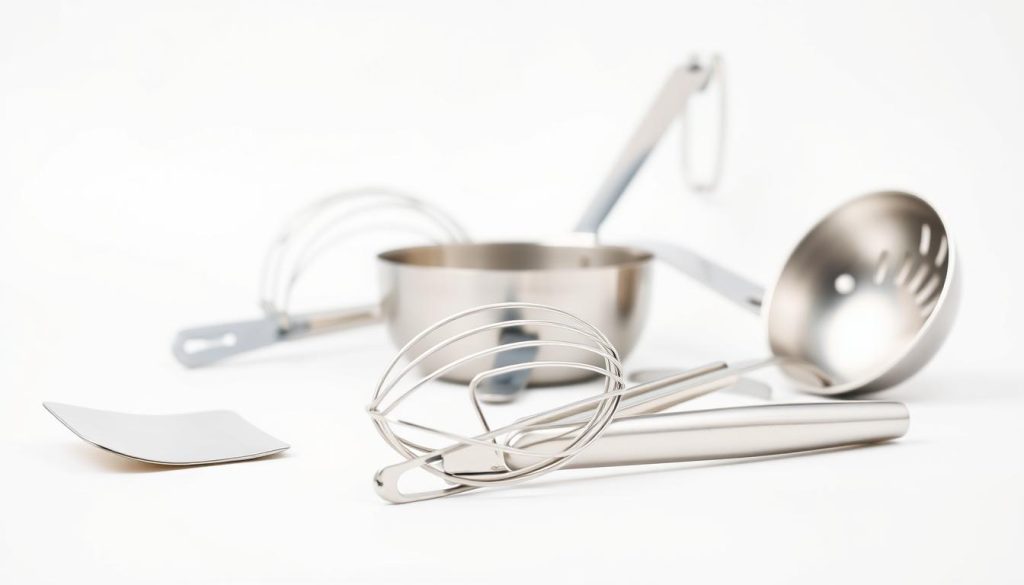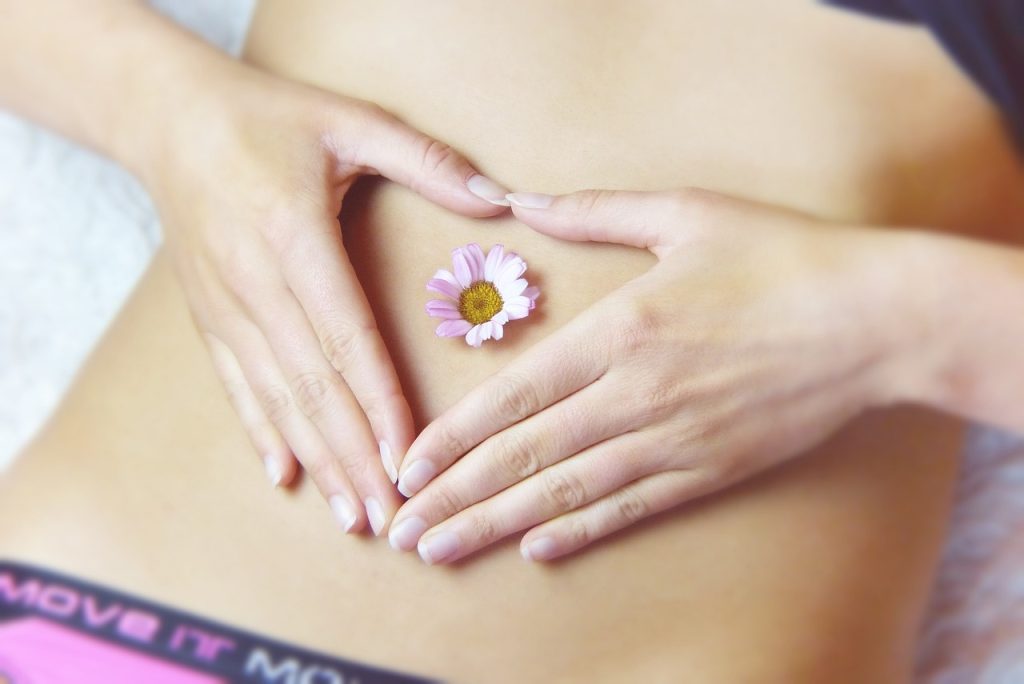Eco-Friendly & Non-Toxic Cooking Utensils
Did you know 90% of eco-friendly cooking utensil brands say their products are safe from harmful chemicals like BPA and PFOA? This shows a big change in the kitchenware world towards safer, non-toxic choices. More people are learning about the dangers of old cooking tools, leading to a big jump in demand for safe kitchenware.

The move towards safe cookware is not just a trend. With 75% of people choosing eco-friendly products, it’s clear health-conscious cooking is here to stay. Non toxic cooking utensils are getting more popular. They’re not just safer, but also better for the planet.
Looking into eco-friendly kitchen tools, you’ll find many options. They’re made from materials like bamboo, silicone, and stainless steel. These alternatives work just as well as old utensils but are safer for your food.
The market for non-toxic cookware is growing fast. It’s expected to hit $5 billion by 2025. This growth comes from people like you who want healthy and sustainable kitchens. By picking safe cookware, you’re keeping your family safe and helping the planet.
Key Takeaways
- 90% of eco-friendly utensil brands claim to be free from harmful chemicals
- 75% of consumers prefer eco-friendly products
- Non-toxic cookware market projected to reach $5 billion by 2025
- Sustainable materials include bamboo, silicone, and stainless steel
- Choosing safe cookware benefits both health and the environment
Understanding the Importance of Safe Kitchen Tools
Safe kitchen tools are key to a great cooking experience. With more folks choosing healthy cooking, demand for Non-Toxic Cooking Utensils and BPA-free gadgets has soared. Let’s dive into why these tools are vital for your health and the planet.
Health Risks of Traditional Cooking Utensils
Traditional cookware often has harmful substances that can get into your food. Research reveals 90% of consumers are concerned about toxic materials in cooking tools. Even nonstick pans can release dangerous chemicals in just two minutes of overheating, which is a big health risk.
Environmental Impact of Kitchen Tool Choices
Your kitchen tool choices impact more than just your health. A survey shows 70% of chefs value sustainable materials in their gear. Choosing Non-Toxic Cooking Utensils cuts down on your carbon footprint and supports green practices.
The Rise of Non-Toxic Alternatives
The market for healthy cooking tools is growing fast. Now, 60% of consumers prefer eco-friendly and Non-Toxic Cooking Utensils. These options, like ceramic nonstick, conduct heat well and resist scratches without the dangers of old tools. As more people learn about these safer options, they’re switching to better kitchen tools.
| Feature | Ceramic Nonstick | Conventional Nonstick |
|---|---|---|
| PFAs-free | Always | Never |
| Toxic Fume Emission | Never | Under 2 minutes |
| Heat Conduction | High | Low |
| Scratch Resistance | High | Low |
What Makes Cooking Utensils Non-Toxic
Non-toxic cooking utensils are becoming more popular. This is because people are learning about the dangers of old kitchenware. These new utensils are made from materials that don’t harm your food.
USA manufacturers are at the forefront of making safe cookware. Their products meet high standards, avoiding harmful substances like PFAS and lead. This makes American cookware safer than many imported brands.
Key materials for non-toxic utensils include:
- Stainless steel: Durable and non-reactive, ideal for high-heat cooking
- Cast iron: Naturally non-stick when seasoned and adds beneficial iron to food
- Pure ceramic: Free from metals and toxins, withstands high temperatures
- Glass: 100% inert, doesn’t react with food or contain harmful coatings
When looking for non-toxic kitchenware, check for certain labels. Look for PFOA-Free, PTFE-Free, and California Prop 65 Compliant. NSF Certification is also important. These labels show the products are safe and free from harmful chemicals.
Essential Materials for Non Toxic Cooking Utensils
Choosing the right materials for your kitchen tools is key when looking at sustainable cookware brands. Non-toxic utensils keep you healthy and help make your kitchen greener. Let’s look at the main materials used in making safe and long-lasting cooking tools.
Stainless Steel Benefits and Properties
Stainless steel is a top pick for Non-Toxic Cooking Utensils sets. It’s tough, doesn’t react with food, and won’t rust. It’s great for spatulas, tongs, and serving spoons. Stainless steel tools can handle high heat and are dishwasher safe, making them easy to keep clean.
Wood and Bamboo Options
Wood and bamboo are good alternatives to plastic utensils. They’re kind to your cookware and won’t scratch it. A spatula made from bamboo or wood is perfect for non-stick surfaces.
Food-Grade Silicone Advantages
Silicone utensils are becoming more popular in kitchens. They’re heat-resistant, flexible, and safe for cooking and baking. Food-grade silicone is a top choice for spatulas, whisks, and baking mats.
Composite Materials Innovation
Composite materials mix the best of different materials. For example, a utensil set might have stainless steel handles and silicone heads. This gives you durability and heat resistance in one tool.

| Material | Heat Resistance | Durability | Eco-Friendliness |
|---|---|---|---|
| Stainless Steel | High | High | Recyclable |
| Wood/Bamboo | Medium | Medium | Biodegradable |
| Food-Grade Silicone | High | High | Long-lasting |
| Composite | High | High | Varies |
Choosing utensils from these safe materials is good for your health and the planet. Quality non-toxic utensils can last for many years. This reduces waste and the need for often buying new ones.
Dangerous Chemicals to Avoid in Kitchen Tools
When looking for non-toxic cooking utensils, it’s key to know about harmful substances in many tools. Your health and safety depend on picking utensils free from chemicals.
BPA and Its Risks
BPA is in some plastic utensils and can get into your food, affecting hormones. The safest utensils don’t have BPA. Choose BPA-free options to keep you safe.
PFAS and PFOA Concerns
PFAS and PFOA, used in non-stick coatings, are harmful. They can mess with hormones and cause long-term health problems. Traditional nonstick pans, like Teflon, release toxic fumes when too hot. They’re not safe for cooking.
Harmful Plastics and Additives
Many cookware brands say they’re eco-friendly but might still have toxic stuff. Uncoated aluminum can change flavor and safety of acidic foods. Some stainless steel cookware from abroad has high nickel levels, which can get into food.
To pick the safest cooking utensils, look for PFOA-Free, PTFE-Free, and California Prop 65 Compliant labels. Choosing chemical-free utensils means you’re caring for your health and the planet.
Sustainable Wood and Bamboo Options
Wood and bamboo are great for eco-friendly kitchen tools. They’re a natural choice instead of plastic or metal. Bamboo is especially good because it grows fast and fights off germs.
Wood brings different looks to your kitchen. Olive wood adds elegance, while beech and maple are tough. These utensils are not only pretty but also gentle on your cookware.
It’s easy to take care of wood and bamboo utensils. Just wash them by hand with mild soap and warm water. Dry them right away. Sometimes, use food-grade mineral oil to keep them shiny and prevent damage. With the right care, they can last for many years, helping your kitchen be greener.
- Bamboo utensils are biodegradable and compostable
- Wood options include olive, beech, and maple
- Natural antimicrobial properties in bamboo
- Gentle on cookware surfaces
- Easy to care for with simple maintenance
Choosing wood and bamboo utensils means you’re helping the planet. They cut down on plastic waste and support green manufacturing. Switch to natural materials today and make your kitchen warmer and more beautiful.
The Benefits of Stainless Steel Utensils
Stainless steel utensils are becoming a favorite for safe cooking. They are durable, safe, and good for the environment. This makes them a key item in many kitchens today.

Durability and Longevity
Stainless steel utensils are made to last. They can last over 30 years, much longer than plastic. This means you won’t need to replace them often, saving you money.
The demand for stainless steel is growing fast. In 2021, the market was worth $120 billion. It’s expected to grow by 5.3% each year until 2030.
Safety Features
Stainless steel is a safe choice for cooking. It doesn’t release harmful chemicals into your food like some plastics do. It’s also non-porous, which stops bacteria from growing.
It can handle high temperatures without melting or bending. A survey in 2022 showed 75% of people prefer stainless steel over plastic for these reasons.
Maintenance Tips
Keeping your stainless steel utensils clean is easy. Just wash them with warm, soapy water after each use. For tough stains, try soaking them in baking soda and water.
Don’t use harsh cleaners that can scratch them. With the right care, your stainless steel tools will stay in great shape for years.
| Feature | Benefit |
|---|---|
| Recyclability | 100% recyclable, reducing landfill waste |
| Environmental Impact | 60% less CO2 emissions compared to plastic production |
| Market Growth | Expected to reach $10 billion by 2025 |
Food-Grade Silicone: A Modern Solution
Food-grade silicone is revolutionizing kitchen tools. It’s a safe, flexible material for cooking and baking. You’ll find it in many bpa-free kitchen gadgets, like spatulas and ice cube trays.
Silicone is great because it can handle high heat and doesn’t stick. Unlike regular pans, it doesn’t release harmful fumes when heated. This makes it perfect for health-conscious cooks who want non-stick safe pans.
When buying silicone utensils, choose high-quality, food-grade ones. These are free from toxic chemicals and safe for food contact. Many toxin-free bakeware items are made from silicone, offering a durable and easy-to-clean alternative to traditional materials.
| Feature | Silicone Utensils | Conventional Nonstick |
|---|---|---|
| PFAS-free | Always | Never |
| Toxic fume release | Never | Under 2 minutes |
| Heat conduction | High | Low |
| Scratch resistance | High | Low |
Silicone is very versatile in the kitchen. You can use it for baking, cooking, and storing food. Its flexibility makes it easy to pop out muffins or release ice cubes. Plus, silicone tools are dishwasher-safe, making cleanup easy.
Choosing food-grade silicone means picking a safer, more eco-friendly option for your kitchen. These tools last longer than plastic ones, reducing waste. Switch to silicone and enjoy worry-free cooking with durable, non-toxic utensils.
Proper Care and Maintenance of Eco-Friendly Utensils
Looking after your non toxic cooking utensils makes them last longer and stay safe. Here’s how to keep your chemical free cooking utensils in great condition.
Cleaning Best Practices
Wash your eco-friendly utensils with warm, soapy water after each use. For tough stains on ceramic or stainless steel, mix baking soda and water to make a paste. Don’t use harsh scrubbers that can scratch the surface. Wooden utensils need special care – wash them by hand and dry them right away to stop warping.
Storage Recommendations
Keep your utensils in a dry, clean spot. Use drawer dividers to keep different materials apart. Hang wooden spoons and spatulas to dry completely. For silicone, store it flat to avoid warping.
Extending Utensil Lifespan
Regular care helps your eco-friendly tools last longer. Oil wooden utensils every month to stop them from cracking. If your non-stick pans are scratched or peeling, replace them if they were made before 2013. Use wooden or silicone utensils with ceramic cookware to avoid scratching.
| Utensil Material | Cleaning Method | Storage Tip | Lifespan Extension |
|---|---|---|---|
| Stainless Steel | Dishwasher safe | Hang or lay flat | Polish occasionally |
| Wood/Bamboo | Hand wash only | Hang to dry | Oil monthly |
| Silicone | Dishwasher safe | Store flat | Avoid high heat |
| Ceramic | Hand wash recommended | Stack with care | Use gentle utensils |
Top Brands for Sustainable Kitchen Tools
Many Non-Toxic Cooking Utensilsl brands stand out. They offer non-toxic options without losing quality or performance.
360 Cookware is a leader with their USA-made stainless steel products. They focus on durability and non-toxic materials, appealing to health-conscious cooks. Xtrema offers pure ceramic cookware, a safe and eco-friendly choice compared to traditional non-stick pans.
Lodge Cast Iron has been making durable, non-toxic cookware for years. Their traditional and enameled cast iron pots and pans are loved by both home cooks and professional chefs. Heritage Steel provides premium stainless steel kitchen tools that are built to last.
| Brand | Specialty | Material |
|---|---|---|
| 360 Cookware | Stainless Steel | USA-made |
| Xtrema | Pure Ceramic | Non-toxic |
| Lodge Cast Iron | Traditional & Enameled | Cast Iron |
| Heritage Steel | Premium Stainless | Stainless Steel |
These brands focus on sustainability, using eco-friendly processes and durable materials. By choosing their products, you support companies that care about your health and the environment.
Making the Switch to Eco-Friendly Kitchen Tools
Switching to green cooking tools is easy. Just check your kitchen tools and replace them slowly. This way, you’ll have a healthier and greener kitchen.
Assessing Your Current Kitchen Tools
First, list all your kitchen utensils. Find out which ones might have harmful chemicals or are worn out. Replace the tools you use most, like spoons and spatulas, first. This can cut down on harmful substances by up to 30%.
Gradual Replacement Strategy
Replace your tools step by step with non-toxic sets. Start with the most used items, like spoons and cutting boards. Replacing just 20% of your tools can make a big difference for the environment.
Budget-Friendly Options
You don’t have to spend a lot to go green. Watch for sales on stainless steel or bamboo tools. Buying multi-purpose items can also help. Quality tools last longer, saving you money in the long run.
- Use Command hooks to organize your new Non-Toxic Cooking Utensils, saving up to 30% of kitchen space
- Opt for glass containers instead of plastic – 60% of consumers prefer them for their non-toxic properties
- Choose seasonal produce to save up to 30% on grocery bills while supporting sustainable farming practices
By choosing wisely and slowly adding green tools, you can make your kitchen healthier and greener. And you won’t have to spend a lot.
Conclusion
Choosing Non-Toxic Cooking Utensils is key for your health and the planet. Safe options like ceramic and silicone are great alternatives. Ceramic cookware, free from harmful substances, offers a non-stick surface without metal risks. It’s versatile and can handle high temperatures.
Silicone spatulas are a big step forward in eco-friendly kitchen tools. They can handle up to 400°F, perfect for most cooking. The FDA says food-grade silicone is safe, so you can cook with confidence. Plus, they’re easy to clean and maintain, making cooking easier.
Choosing eco-friendly kitchen tools helps your health and the environment. The demand for sustainable products is growing. Start with a silicone spatula or a ceramic mug. Gradually add more non toxic cooking utensils. Your health and the planet will appreciate it.
FAQ
What are the main materials used in Non-Toxic Cooking Utensils?
Non-toxic cooking utensils are made from stainless steel, wood, bamboo, and food-grade silicone. They also use innovative composite materials. These choices are safe, durable, and good for the environment.
Why should I switch to eco-friendly and non-toxic cooking utensils?
Switching to eco-friendly utensils protects your health and the environment. They are durable and sustainable. This makes them a smart choice for your kitchen.
What chemicals should I avoid in kitchen tools?
Avoid tools with BPA, PFAS, PFOA, and other harmful plastics. These chemicals can harm your health and contaminate your food.
Are wooden utensils safe and eco-friendly?
Yes, wooden utensils are safe and eco-friendly. They’re made from renewable resources and don’t harm your food. Olive, beech, and maple woods are good choices.
How do I properly care for my Non-Toxic Cooking Utensils?
Hand wash your utensils with mild soap and warm water. Dry them well and store them in a clean place. Don’t soak wooden utensils, and avoid the dishwasher for silicone and wood. Oiling wooden utensils helps keep them in good shape.
What are the benefits of stainless steel utensils?
Stainless steel utensils are durable and last long. They’re safe for high heat and work with all cooktops. They’re also easy to clean and maintain.
Is food-grade silicone safe for cooking?
Yes, food-grade silicone is safe for cooking. It’s heat-resistant and doesn’t react with food. Make sure to buy from trusted brands that use genuine food-grade silicone.
How can I transition to eco-friendly kitchen tools on a budget?
Start by replacing your most used items first. Look for sales and discounts on quality brands. Buying sets and affordable options like bamboo can help. Durable pieces save money in the long run.
What are some top brands for sustainable kitchen tools?
Top brands include 360 Cookware for stainless steel, Xtrema for ceramic, and Lodge Cast Iron for non-toxic cast iron. Bambu offers bamboo utensils, and GreenPan has eco-friendly non-stick cookware.
Are non-stick pans without PFOA and PTFE safe?
Non-stick pans without PFOA and PTFE are safer than traditional ones. But, check the materials and the brand. Ceramic-coated and well-seasoned cast iron pans are good, non-toxic options.
Source Links
- https://www.stripesandwillows.com/lifestyle/non-toxic-cookware-made-in-usa?srsltid=AfmBOorj2tglsPPGoAYRbAccVHsKutKs2HD67gBQ_dig9tR1kuygabwL
- https://www.greenpan.us/products/platinum-silicone-solid-turner-red
- https://www.carawayhome.com/products/mini-fry-pan?group=muffin-pans&quantity=6-piece-set
- https://www.upworthy.com/why-cooking-is-a-metaphor-for-life-from-a-professional-chef
- https://www.greenpan.us/products/bobby-flay-by-greenpan-professional-ceramic-nonstick-13-piece-cookware-set-graphite
- https://www.yahoo.com/lifestyle/biggest-cooking-oil-recalls-us-141500150.html
- https://www.stripesandwillows.com/lifestyle/non-toxic-cookware-made-in-usa?srsltid=AfmBOoqtC3w_kI1cCQpl-28-wl5bUbwx87VDXFr22Lm9q8m7kufZFLqn
- https://www.carawayhome.com/products/mini-fry-pan?color=slate&size=10.5-inch&quantity=single
- https://www.greenpan.us/products/stanley-tucci™-ceramic-nonstick-11-piece-cookware-set-with-the-tucci-cookbook-milano-black
- https://www.carawayhome.com/products/deluxe-cookware-set?color=stone&value=25&quantity=12-piece-set
- https://www.stripesandwillows.com/lifestyle/non-toxic-cookware-made-in-usa?srsltid=AfmBOoqzJG5DGjBcz7kv4SqmY2S-PCjaj_q8NgKt-9dMDGc7mv0YnvWv
- https://www.stripesandwillows.com/lifestyle/non-toxic-cookware-made-in-usa?srsltid=AfmBOooNKYjirpanI7jLe00XAbZsKqOF-EG74ObIIwx-UAxSH-lYrS9Y
- https://www.carawayhome.com/products/fry-pan-duo?color=mist&size=6-glass-lid
- https://www.zerolife-eco.com/oven-safe-pulp-baking-trays-vs-traditional-4/
- https://advancedbiofuelsusa.info/
- https://shop.buildwithrise.com/products/home-of-wool-5-oeko-tex-wool-filled-mattress?srsltid=AfmBOooympMecsHbXj03E1HF7u-zwtnNA4Y-u7HREnz2R2ceC2tWdrnc
- https://www.indianretailer.com/article/whats-hot/trends/Catalogue-Retailing-in-Infancy.a300
- https://www.greenpan.us/products/elite-convection-air-fryer-toaster-oven-premiere-stainless-steel
- https://www.yahoo.com/lifestyle/10-ways-home-move-ready-110204429.html
- https://downtoearthorganics.com.au/blogs/healthy-lifestyle-habits-techniques/is-ceramic-cookware-safe-what-every-health-conscious-kitchen-needs-to-know?srsltid=AfmBOooKaA-VeK7HSdonFGsi56o8ouVjl9Maqy5mFwYrFhk4ndRks8MZ
- https://www.carawayhome.com/products/muffin-pan?group=muffin-pans&quantity=6-piece-set
- https://www.greenpan.us/products/premiere-silicone-tasting-spoon-black
- https://news.yahoo.com/news/lifestyle/why-consumers-prefer-natural-fibers-104819050.html
- https://www.yahoo.com/lifestyle/tiny-tools-easy-affordable-solution-151500758.html
- https://www.preparationcall.com/sustainable-practices-for-long-term-food-storage/
- https://oregonwellnessclinic.bloggactivo.com/33168437/health-benefits-of-non-toxic-ceramic-cookware
- https://www.shengyansilicone.com/News/are-silicone-spatula-safe.html
Non-Toxic Cooking Utensils Non-Toxic Cooking Utensils Non-Toxic Cooking Utensils Non-Toxic Cooking Utensils Non-Toxic Cooking Utensils Non-Toxic Cooking Utensils Non-Toxic Cooking Utensils Non-Toxic Cooking Utensils Non-Toxic Cooking Utensils Non-Toxic Cooking Utensils Non-Toxic Cooking Utensils Non-Toxic Cooking Utensils Non-Toxic Cooking Utensils Non-Toxic Cooking Utensils Non-Toxic Cooking Utensils



